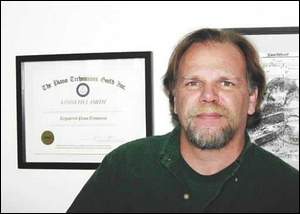 |
||||||||||
|
The Piano Man Ken Smith worked for years as an apprentice piano technician before going into business on his own from his Somerville home roughly 20 years ago. That home eventually filled with 20 or 30 pianos in various stages of repair, scattered into every open space, much to the chagrin of his wife, Mary. The Smiths opened their new Pianosmith retail location on Main Street in Somerville this past spring. All those pianos-in-progress have joined a wide assortment of used and refurbished spinets, grands, baby grands, uprights and the Smiths' favorites, the player pianos. Several years ago, Smith ran into other piano technicians who were members of the Piano Technician Guild, the official organization of Registered Piano Technicians, based in Kansas City and with 4,100 members worldwide. The stated mission of the guild is to promote the highest standards for piano technician's professional development by recognizing technical competence and advancing the interests of its members. "About 25 percent of the piano technicians in the USA are members of the Piano Technician Guild," said Smith. Membership is open to anyone interested in piano technology, but to become a Registered Piano Technician, or RPT, members must pass a rigorous series of technical examinations. Only about half of Piano Technician Guild members have become certified RPTs. Smith decided he liked the idea of being able to mingle and exchange tips and ideas with other professionals in his field, so he joined the Southeast Pennsylvania chapter that meets outside Philadelphia. "A lot of the guys wear red jackets to the gatherings," said Smith. "So they like to call themselves redcoats." "There's a high level of encouragement among members. We help each other with ideas, problems we may have come up against and solved, discuss tunings, etc. We have Internet forums as well as in-person meetings and get-togethers." Once he was in with the redcoats, Smith decided to take advantage of the RPT certification program. The exams are taken in three distinct sections, each lasting about three hours. The first part is a written exam in basic knowledge of piano design, tuning theory, repair and general piano technology. Next comes the standardized tuning exam. In this test, the technician completely tunes a piano under the scrutiny of three RPT examiners, using his ears, along with sophisticated digital tuning instruments. They match his completed tuning to a piano they have previously tuned as a "standard" and measure his against theirs. The final exam is a technical test. The examinee must assemble a bag of parts into a perfectly functioning action model. This includes a repair test, covering typical in-home repairs, such as broken strings, key repairs and broken action parts. Displaying your certification as a qualified technician on your showroom wall can be a good enough reason to go through such a painstaking series of tests. But there's more to it for Smith. "The objective of the testing really is to give you a sense of achievement," said Smith. The tuning of a piano constantly changes with its environment. Rust on the wires, tension, age, temperature, humidity, all sorts of factors affect the tuning. "Out in the field, every piano is different," said Smith. "What you're hearing is a harmonic relationship of the strings. Every piano is basically out of tune with itself at most times." There are actually only technical frequency standards for the "A" keys. The "A" key above middle "C" is tuned to a mathematical frequency of 440 cycles. The next "A" key up is 880 cycles, and the next "A" up is 1760 cycles. Starting from that first "A" 440 key, the next one down is 220 cycles, and next "A" down is 110 cycles. "But all the other keys in between, we tune to where we think they sound right," said Smith. A technician matches those "A" keys to frequency with a pitch pipe, a digital tuner or tuning fork. There is even a program for a PDA that "hears" the note as played on the piano, then shows the frequency in decimal numbers and a visual waveform on the screen, like a pocket oscilloscope. "I prefer doing the fine tuning by ear," said Smith. Pianos are very intricate mechanisms. A typical grand piano has more than 7,000 parts. The 88 keys activate hammers, fashioned from pressurized wool, through a series of hinges. The hammers hit a series of roughly 230 wires, called strings, held in a cast-iron frame under intense tension. These strings connect to a pin block of pins that are tightened for tuning. Energy from the strings' vibration moves into the soundboard, through the air, and finally into your ears. "A grand piano has enough tension in the strings that, if you could hook them up, you would be able to suspend two or three Chevy Suburbans," said Smith. The keys, hammers, strings, dampers, pedals all must be in perfect working order for the piano to play properly. "It isn't just about tuning," said Smith. "Maintaining a piano regularly is very important. Pedals need to be adjusted, sticky keys unstuck. Mechanical function is essential. Strings lose their resilience over time, and a good ear can hear the difference." Smith recommends tuning and maintaining a typical home piano twice a year. School pianos or any pianos receiving heavy use should be tuned and maintained even more often. A technician should tune any professionally used piano before every performance.
|
|||||||||
 What
does a piano tuner, or to use the preferred term, piano technician, do
when he wants to prove he is at the top of his game? The only way is to
be certified as a Registered Piano Technician by the Piano Technician
Guild.
What
does a piano tuner, or to use the preferred term, piano technician, do
when he wants to prove he is at the top of his game? The only way is to
be certified as a Registered Piano Technician by the Piano Technician
Guild.